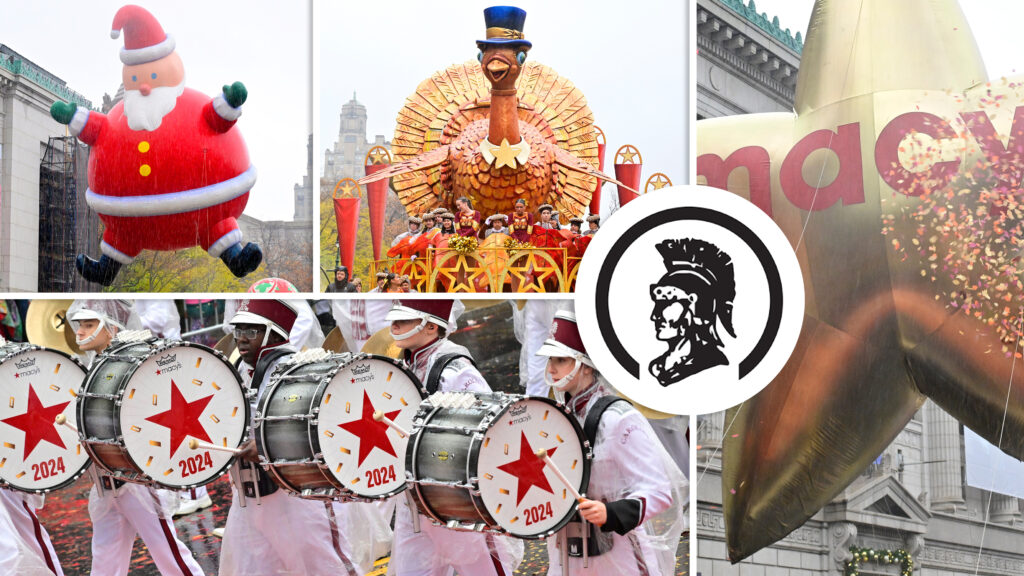In 2013, Troopers and Crossmen had several head-to-head meetings, with Crossmen finishing ahead at most of those events.
Come the 2013 DCI World Championship Prelims in Indianapolis, Troopers finished 14th, behind the Crossmen and 1.90 points under the 12th place Blue Stars. But in the Semifinals, Troopers turned the tables and surged past the Crossmen by 1.30 points to score within a tenth and a half of earning a spot among the top 12 finalist corps.
Troopers’ “Magnificent 11” production paid homage to Caspar Collins and the 11th Ohio Cavalry. Collins was a young lieutenant in the brigade who fought to defend the river crossings near what is now Casper, Wyoming. The corps’ hometown city is named for him, but with a slightly different spelling. Collins was killed in 1865 while leading a handful of soldiers into battle against overwhelming odds. The crossed-sword emblem of the 11th Ohio Cavalry has long been emblazoned on various elements of the Troopers’ uniforms.

The numeral “11” was a key theme throughout this production. It appeared in drill formations 11 times, sometimes sideways and sometimes mutated. The number was also seen in the color guard flags utilized for the corps’ opening sunburst that is an iconic corps drill maneuver that has graced many Troopers productions. There were also 11 buttons on the blue uniforms that were a throwback to the corps’ dress of the 1980s.
The color guard wore modern dress costumes of a patchwork design that reflected the earth tones of pioneering women’s wear. Those performers helped to keep a faded, apparently weather-beaten replica of the Bennington Flag elevated by various corps members throughout the show. The Bennington is the Revolutionary War flag with 13 stars and 13 stripes representing the original states of the union, and the numeral “76” emblazoned upon the blue section of the flag. The flag was often held at a 45-degree angle, replicating how it was carried into battle by a horseman holding the pole from the base of his saddle with his free hand.
In addition to the visuals, the music was also unmistakably western in character, opening with “Fanfare for the 11th,” an original work by DCI Hall of Fame member and corps arranger Robert W. Smith. Smith is best known as one of the most popular composers and creators of training literature for school bands. He got his start writing for drum corps with Suncoast Sound, a perennial DCI finalist from Florida in the 1980s.

In the corps’ opening drill set, the trumpets formed an askew “11” and the flags opened with the first sunburst of the show. Simultaneously, eight color guard members performed another homage to the corps’ distant past by gathering in a circle around the raised Bennington Flag and tossing their rifles across the circle, just barely whizzing by the flag bearer. In the “old days,” this maneuver was typically performed with the guard sergeant or drum major in the middle of the circle.
The next selection was “The Magnificent Seven” by Elmer Bernstein, written for the 1960 film of the same name that was previously performed by the corps in 1966, 1988, 1997, and 2004. The film was an American old west remake of a 1954 Japanese film, “The Seven Samurai,” focusing on seven gunslingers hired to protect the citizens of a Mexican village under attack from roving bandits.
In a prolific career that spanned more than five decades, Elmer Bernstein wrote music for hundreds of television shows and films. His career went into a tailspin after being censured during the 1950s for refusing to cooperate with the House of Un-American Activities Committee. He recovered and went on to write some of the most iconic film scores ever, including “The Ten Commandments,” “Animal House,” “Ghostbusters,” and “The Blues Brothers,” as well the theme for “National Geographic” television specials and Michael Jackson’s “Thriller” video.

Toward the end of the piece, the horns spun around into an “11” surrounded by a rectangle, which was a representation of the corps’ belt buckle. The massed corps shout of “HLD,” heard upon the last note of the piece, stood for Troopers’ slogan of “Honor, Loyalty, Dedication.” One member of the color guard held aloft two crossed sabres, the logo of the 11th Ohio Cavalry that is typically seen on the corps’ hats.
John Barry wrote the elegiac “John Dunbar Theme” for the 1990 film, “Dances With Wolves,” which the Troopers used accompanied by flags appearing as strata of rolling hills under an open western sky. “Dances with Wolves” was directed and produced by Kevin Costner, who also played the lead character. The film won seven Academy Awards, including that for Best Picture.
Percussion arranger Paul Rennick composed the corps’ percussion feature titled “Tribal Spirits.” Originally just written for percussion, throughout the season brass players were gradually added to sporadic moments throughout the piece. The color guard members removed their flowing skirts at this point for a more streamlined look and to accommodate more athletic movement.

A mainstay in Troopers’ repertoire over many years, “Battle Hymn of the Republic” started life in 1856 as a song composed by William Steffe that was originally titled, “John Brown’s Body,” the tune paying homage to the storied abolitionist at the forefront of the fight to end slavery. The melody became more famous in the early 1860s when Julia Ward Howe wrote lyrics to the tune.
The corps played “Battle Hymn” 20 times prior to 2013, but no version was as haunting as this one due to its somber character. Flags took on a rich golden hue across stripes of different strata, which turned out to be golden versions of the Bennington Flag. These silks became a literal sunburst when the full corps performed its iconic drill maneuver toward the end of the show, with the music brightening along with the visual “pop.”
Inside the circle, lifting up the original Bennington Flag, a performer wore the corps’ traditional white guard sergeant uniform of the 1960s and 1970s, an effect added to the show the weekend before the DCI World Championships.
Seconds from the end of the show, the full horn line formed an angled numeral “11” and pivoted the form to face the audience head on, an impossible-to-miss reminder of the theme of the show.
After the mellowness of the second movement, the corps let everyone know the slumber was over with the “Allegro agitato (fast and restless)” third movement, which Gershwin described as “an orgy of rhythms.” The front ensemble percussion again captured the most virtuosic elements of the original piano flourishes, leading into a slowly building push into the final statement of the show.
The color guard members picked up solid red flags for the end as the horns played the climax of the group’s iconic “Let It Be Me” closer that had served the corps for many of its earlier years.
It was as if the corps was stating that even though they verged into the symphonic orchestra repertoire, they were still, first and foremost, Spirit of Atlanta.

Michael Boo was a member of the Cavaliers from 1975-1977. He has written about the drum corps activity for more than 35 years and serves as a staff writer for various Drum Corps International projects. Boo has written for numerous other publications and has published an honors-winning book on the history of figure skating. As an accomplished composer, Boo holds a bachelor's degree in music education and a master's degree in music theory and composition. He resides in Chesterton, Indiana.





